住宅室内采暖系统节能设计方案(Energy-saving-design-scheme-of-resi
- 格式:doc
- 大小:22.72 KB
- 文档页数:17

住宅室内采暖系统节能设计方案(Energy saving design scheme of residential indoor heating system)The energy-saving design of residential indoor heating systemEnergy conservation is a long-term strategic policy of china. The Chinese government attaches great importance to energy saving work, especially after the reform and opening up energy-saving work appeared thriving situation. Energy saving for the heating industry potential is quite large. The heating industry is large energy consumption, energy consumption expenditure occupy most of its cost. Because the previous residential heating heat fee according to the area, there is much irrationality, and is not convenient for the users of local regulation, causing great waste heat heating. With the continuous development of the improvement of people's living and heating business, to achieve the heating system with heat metering and independent control is more and more high.In recent years, such problems in heating system design has been paid more and more attention. So it is necessary to meet the need of heat metering charges by using more suitable forms of heating system in new residential. In such problems, especially should pay special attention to the energy utilization process before, namely the design of the heating system in the planning, should consider the prospects of energy saving and economic benefit of the system. The Ministry of construction "construction" 95 "plan and the 2010 plan" clearly pointed out that "the civil construction and installation of central heating heat meter and related regulating equipment andmetering work, 1998 through pilot success, began to promote the implementation of small area in 2000 2010 in the new key city, comprehensive promotion". Therefore, in the design of indoor heating system, the designer should consider the needs of users of household heat and room temperature control. According to preliminary estimates, take household metering heating, heating and energy saving can be achieved more than 20%. In this paper, several kinds of household metering heating system for an analysis.2, the basic form of the old heating system and its advantages and disadvantagesFor a long time, basically adopts the single vertical system design design of city residential indoor heating system in china. (Figure 1) this design has many advantages: 1 simple and convenient construction system; 2; 3 low cost, but also has some defects, is not convenient for the users of local regulation, thus causing a waste of energy. With the change of energy structure and energy saving and property management requirements, this problem is more and more obvious, the heating system had to be replaced.With the development of our socialist market economy, "hot" is the view of commodities has gradually been recognized and accepted by people. The traditional method of backward construction area by clearing fees, is neither scientific nor reasonable. Has been unable to meet the requirements of socialist market economic system must be reformed, metering and charging. Heating charges by the planned economy period of thewelfare system to socialist market economic system, namely the user to heat the heating enterprises pay heating fee. The user of energy-saving heating system more and more attention. Single pipe vertical heating system defects more and more obvious, the disadvantages in the following aspects:2.1 system does not have the ability of individual adjustmentThe main disadvantage of single pipe vertical heating system is not conducive to local regulation, to improve and meet the thermal comfort requirements of heat users. And because the system is the first hot water for residential buildings to the top, then turn down to the user, which in theory caused by the heat transfer coefficient of K radiator heat users on different floors of the values are not equal. The resulting top bottom overheating too cold, uneven phenomenon. The top user overheating only through the open doors and windows way to let the heat to reduce the indoor temperature, which resulted in a waste of energy. If by adjusting the hot water flow to reduce the room temperature, it will cause the following layers of supercooling phenomenon. Secondly, the system is unable to each room separately adjusted, resulting in a waste of energy.A waste of energy 2.2 system maintenanceThe single pipe vertical heating system is an integral part of the hot water circulation system. If the system has a facility Water Leakage or blocked, the whole system will be affected. May cause the whole building stop for serious; and will cause a lot of hot water in the maintenance of the waste,In the cold areas may appear serious problems such as water supply pipe burst, causing unnecessary accidents, affecting the normal life of the residents.2.3 is not conducive to the management of heating DepartmentFor users with difficult heating fee arrears, if you want to stop individual user heating, may affect the entire residential building for stop. Often this down, heating enterprises to make ends meet, years of losses.2.4 idle residential energy wasteAs the indoor heating system is a tube series, so each layer, each house must use heat, otherwise the system will not work correctly. If some users do not want to use heat or some residential long idle, this will inevitably lead to a waste of energy. At present in some non heating and heating in residential development areas, this phenomenon is very prominent.The development prospect and control principle, 3 household meteringAt present, in our country, the study of household metering system has just started, most of them in the trial stage. The indoor heating system for the original single and vertical system, lack of independent adjustment ability, heat users is commodity without a deep understanding of heat, lack ofawareness of energy saving, only the energy consumption of residential heating units in China area is about 2 times higher in advanced countries, and does not facilitate the heating sector management. According to the household metering heating system heating is the direction of development, is the only way to solve difficult charge and saveenergy. With the improvement of living standards people are no longer satisfied with the full and warm, but the constant pursuit of high quality, high quality of life. In Jiangsu Huaian City, new housing each year nearly one million square meters, the new residential mostly in the application of indoor heating, and the Huaian municipal government is currently only West courtyard heating system. Because the city residential indoor heating has just started, so it should be at the forefront of heating in the form of promotion, promotion prospects the implementation of single household heating in the form of control is very considerable.The characteristics of household metering heating system is controlled individually for each user that is independent of each household heating, using a water supply and return system, a table system, the user can separate regulation, shutdown, metering, does not affect other users. To achieve the fundamental method of household metering purpose is to control the user independent system, the specific approach is to set the table and the heat radiator installed on the valve in the household water supply at the entrance. By adjusting the radiator heating room temperature to satisfy the human thermal comfort requirements. Implementation method of radiator adjustment, mainly by controlling the heat dissipation, to meet the temperature requirements. The current regulation isachieved mainly depends on individual radiator radiator hot water flow into the flow change, but must not affect the whole supply regulation method in radiator regulation, is mainly controlled by the heat dissipation, to meet the temperature requirements. The current regulation is achieved mainly depends on the individual radiator method changes into the flow radiator water flow, but must not affect the hydraulic stability of heating system in the radiator heating system regulation, so to improve the regulation and control measures and a high level of operation and management. Otherwise, it is difficult to achieve the true sense of the household metering.4, suitable for household metering heating system4.1 single control heating system4.1.1 horizontal one pipe systemHorizontal one pipe system is a relatively common heating system. It is a total of supply and return water system is provided in each apartment (called system), each user is a small independent system. The total supply and return water riser pipe in the kitchen by the stairs, each layer of supply and return water in contact with the large system (each layer only households), and adjust the valve is shut off and heat metering system in the small entrance pipeline, so that the household heat metering and charging. The advantages of this system are: vertical riser wear floor, does not affect the wall decoration; the shortcoming is: can not control room temperature; each radiator shall air valve; pipeline, the balcony must pass.4.1.2 (single level crossing systemFigure 3 the system principle diagram, with the same type of horizontal series one pipe system, using a large system, the system of supply and return water pipe arranged in the pipeline well.This design scheme should be added and the radiator group number corresponding to the number three valve, control the maximum flow into the radiator for circulating flow 30%. The advantages of this method are: to achieve room temperature control; vertical riser, does not affect the wall decoration; the shortcoming is: ancillary equipment in the pipeline (three valve); pipeline door, balcony should handle each radiator cold air valve shall be provided.4.2 pipe heating system4.2.1 double riser parallel systemFor the double riser parallel system, any layer as long as the user in the radiator pipe and valve can achieve regulating media flow, so as to satisfy the requirements of thermal comfort and energy saving. But this adjustment is in use, should consider the following questions: (a) in the number of floors too prone to the phenomenon of serious vertical imbalance, the vertical height of not more than three layers is appropriate, practical restrictions. (b) across the floor of the riser number. (c) only method suitable for installation of the system heat distribution table adjustment, mainly by controlling the heatdissipation, to meet the temperature requirements. The current regulation is achieved mainly depends on the individual radiator method changes into the flow radiator water flow, but must not affect the hydraulic stability of heating system in the radiator heating system regulation, so to improve the regulation and control measures and a high level of operation and management.4, suitable for household metering heating system4.1 single control heating system4.1.1 horizontal one pipe systemHorizontal one pipe system is a relatively common heating system. It is a total of supply and return water system is provided in each apartment (called system), each user is a small independent system. The total supply and return water riser pipe in the kitchen by the stairs, each layer of supply and return water in contact with the large system (each layer only households), and adjust the valve is shut off and heat metering system in the small entrance pipeline, so that the household heat metering and charging. The advantages of this system are: vertical riser wear floor, does not affect the wall decoration; the shortcoming is: can not control room temperature; each radiator shall air valve; pipeline, the balcony must pass.4.1.2 single level crossing systemWith the same type of horizontal series one pipe system, usinga large system, the system of supply and return water pipe arranged in the pipeline well. This design scheme should be added and the radiator group number corresponding to the number three valve, control the maximum flow into the radiator for circulating flow 30%. The advantages of this method are: to achieve room temperature control; vertical riser, does not affect the wall decoration; the shortcoming is: ancillary equipment in the pipeline (three valve); pipeline door, balcony should handle each radiator cold air valve shall be provided.4.2 pipe heating system4.2.1 double riser parallel systemFor the double riser parallel system, any layer as long as the user in the radiator pipe and valve can achieve regulating media flow, so as to satisfy the requirements of thermal comfort and energy saving. But this adjustment is in use, should consider the following questions: (a) in the number of floors too prone to the phenomenon of serious vertical imbalance, the vertical height of not more than three layers is appropriate, practical restrictions. (b) across the floor of the riser number. (c) system is only applicable to the installation of heat distribution table.The level of 4.2.2 pipe systemThe design scheme of double level, can avoid the double riser parallel system of vertical imbalance, and the system can realize an independent system for household heat meterinstallation, can realize the regulation of individual radiator. Any layer users can conveniently adjust the medium flow through the indoor control valve, so as to achieve a comfortable room temperature, and to achieve the purpose of saving energy, and does not affect other users of heating, but the system should be added and the radiator group number corresponding to the number three valve. The advantages of the scheme that the problem of vertical imbalance of heating system is not easy to solve can be greatly improved; room temperature control,The adjusting performance is better than single pipe system; wall vertical riser, does not affect the disadvantages are: indoor decoration; the lower part of the radiator for backwater pipeline, the balcony door hidden difficulties; bad treatment; cold air valve shall be installed on each radiator5, should pay attention to the problems in the design of heating systemAlthough the household metering has powerful promotion in the new residential area, but in the implementation process inevitably there are some problems in the design of heating system, building design, instrument selection, management etc..5.1 heating system heat load calculation and indoor radiatorHeat load calculation is the basis of heating system design, the design for fear of heating is not blindly increase the hotload value, so that the radiator installation area is too large, will not be conducive to the regulation of temperature control valve on the radiator pipe, the heat index should choose a reasonable estimation method. The indoor radiator location to a reasonable layout, indoor level pipeline will increase, with the existing pipeline space, the influence of interior decoration, furniture layout and balcony doors, difficult to deal with such problems.The 5.2 building materials on the heat transfer performance requirementsThe new building materials can meet the requirements of modern energy-saving room, the heat transfer performance of building materials is ideal. Heating and heat loss of buildings is mainly constituted by the heat retaining structure, accounting for about 73%~77%, followed by the penetration of heat through the air gap of doors and windows, accounting for about 23%~27%, in the heat wall accounted for 23%~34%, thus improving the building insulation performance will reach a good energy saving effect. In addition, the calculation shows that for a non heating room from around the room to obtain the heat transfer can be maintained at 12~14 at room temperature, other users have nearly 1/4~1/5 of the heat to the room, other users will pay more for this part of the heat fee is not reasonable. Therefore, it is necessary to strengthen the house building structure 5.3 heat insulation performance parameters correction and meter checking problem because the envelope tenants are located, different, there must be differences in the same room temperature to keep the heat consumption, heat meter parametersshould be chosen so reasonable. My unit meter at the same table, user verification, heat fee settlement occurred in the dispute. Moreover, the organization of specialized personnel should regularly check meter.5.4 flow heating systemSince the implementation of household metering system, the change of heat load will be very frequent, so the heating system should be able to automatically adjust the amount of heating, the heat load of the track changes required. Should be in the heat exchange station is provided with a device of differential pressure control.5.5 residential setting household metering device, to strengthen energy-saving publicity to raise awareness of energy conservation.Put forward higher requirements for the management of 5.6 heating enterprises.6, conclusionIn summary, for the design of heating system in residential district planning and design, if reasonable, can not only realize the system control and measurement function better, and can reduce energy waste, improve heating social benefits and considerable economic benefits.。
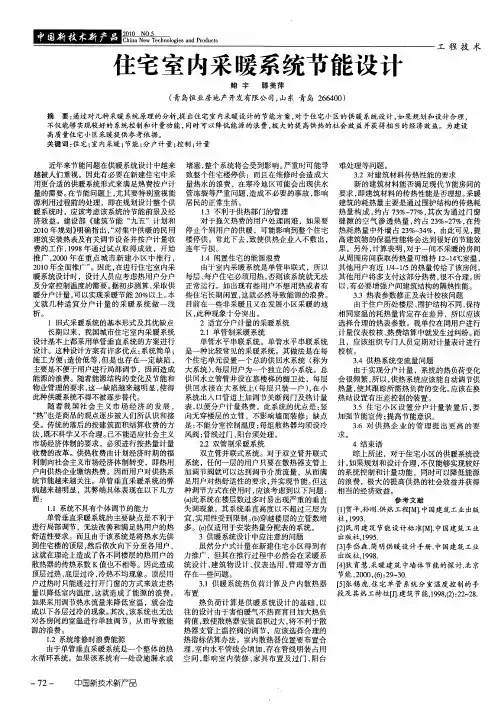
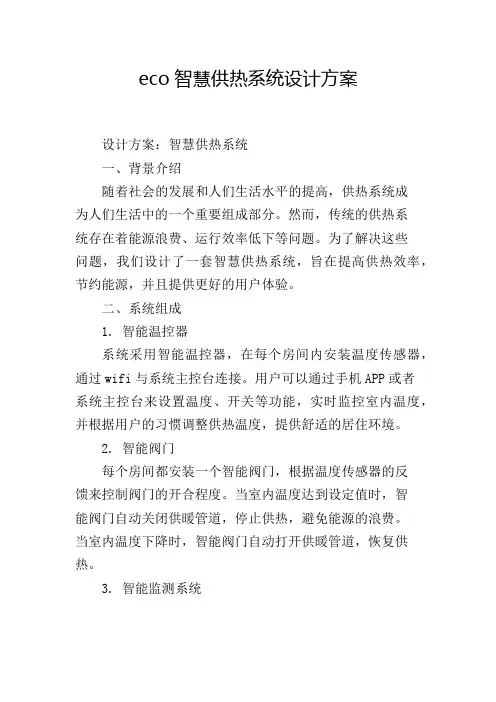
eco智慧供热系统设计方案设计方案:智慧供热系统一、背景介绍随着社会的发展和人们生活水平的提高,供热系统成为人们生活中的一个重要组成部分。
然而,传统的供热系统存在着能源浪费、运行效率低下等问题。
为了解决这些问题,我们设计了一套智慧供热系统,旨在提高供热效率,节约能源,并且提供更好的用户体验。
二、系统组成1. 智能温控器系统采用智能温控器,在每个房间内安装温度传感器,通过wifi与系统主控台连接。
用户可以通过手机APP或者系统主控台来设置温度、开关等功能,实时监控室内温度,并根据用户的习惯调整供热温度,提供舒适的居住环境。
2. 智能阀门每个房间都安装一个智能阀门,根据温度传感器的反馈来控制阀门的开合程度。
当室内温度达到设定值时,智能阀门自动关闭供暖管道,停止供热,避免能源的浪费。
当室内温度下降时,智能阀门自动打开供暖管道,恢复供热。
3. 智能监测系统系统内设有智能监测系统,对供热系统运行情况进行实时监测。
通过数据分析,可以及时发现系统故障,及时处理,提高系统的稳定性和可靠性。
同时,通过对供热系统运行数据的统计和分析,可以优化系统运行策略,提高供热效率。
4. 能源回收系统系统内设有能源回收系统,将供热过程中产生的废热进行回收利用。
通过热交换器将废热与冷却的回水进行热交换,减少能源的浪费,提高整个供热系统的能源利用效率。
5. 外部气象监测系统系统与外部气象监测系统进行联动,通过获取外部温度、湿度等气象数据,系统能够根据不同的气象条件调整供热策略。
在气温较高的情况下,系统可以适当减少供热量,以节约能源;在气温较低的情况下,系统可以增加供热量,提供更好的取暖效果。
三、系统优势1. 提高供热效率通过智能温控器和智能阀门的自动调节,根据用户需求和室内外温度情况进行智能供热控制,避免能源的浪费,提高供热效率。
2. 节约能源能源回收系统的应用可以将供热过程中产生的废热进行回收利用,减少能源的浪费,提高系统的能源利用效率。
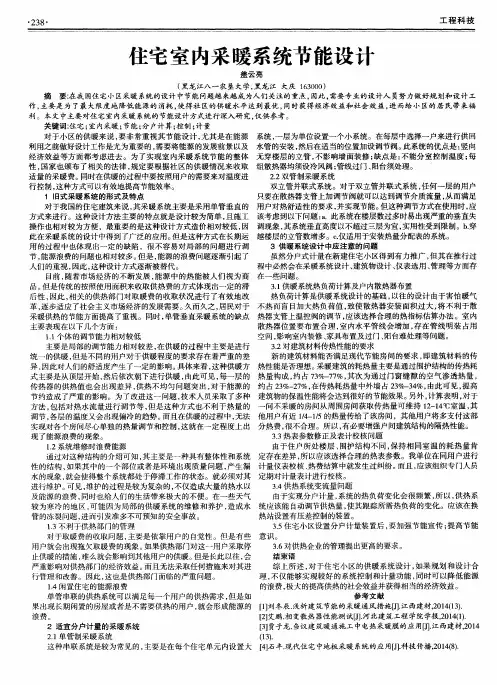
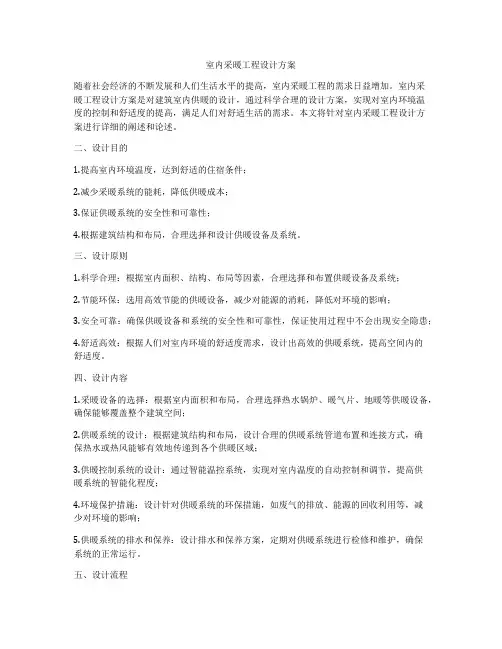
室内采暖工程设计方案随着社会经济的不断发展和人们生活水平的提高,室内采暖工程的需求日益增加。
室内采暖工程设计方案是对建筑室内供暖的设计,通过科学合理的设计方案,实现对室内环境温度的控制和舒适度的提高,满足人们对舒适生活的需求。
本文将针对室内采暖工程设计方案进行详细的阐述和论述。
二、设计目的1.提高室内环境温度,达到舒适的住宿条件;2.减少采暖系统的能耗,降低供暖成本;3.保证供暖系统的安全性和可靠性;4.根据建筑结构和布局,合理选择和设计供暖设备及系统。
三、设计原则1.科学合理:根据室内面积、结构、布局等因素,合理选择和布置供暖设备及系统;2.节能环保:选用高效节能的供暖设备,减少对能源的消耗,降低对环境的影响;3.安全可靠:确保供暖设备和系统的安全性和可靠性,保证使用过程中不会出现安全隐患;4.舒适高效:根据人们对室内环境的舒适度需求,设计出高效的供暖系统,提高空间内的舒适度。
四、设计内容1.采暖设备的选择:根据室内面积和布局,合理选择热水锅炉、暖气片、地暖等供暖设备,确保能够覆盖整个建筑空间;2.供暖系统的设计:根据建筑结构和布局,设计合理的供暖系统管道布置和连接方式,确保热水或热风能够有效地传递到各个供暖区域;3.供暖控制系统的设计:通过智能温控系统,实现对室内温度的自动控制和调节,提高供暖系统的智能化程度;4.环境保护措施:设计针对供暖系统的环保措施,如废气的排放、能源的回收利用等,减少对环境的影响;5.供暖系统的排水和保养:设计排水和保养方案,定期对供暖系统进行检修和维护,确保系统的正常运行。
五、设计流程1.项目调研:了解建筑的面积、结构、布局,确定供暖设备的选择和供暖系统的设计方案;2.方案设计:根据调研结果,设计供暖设备的布置方案、供暖系统的管道布置方案、温控系统的设计方案等;3.成本估算:根据设计方案,对供暖设备和系统的成本进行估算,确保项目的经济性;4.图纸设计:编制供暖设备和系统的图纸设计,包括设备的安装图纸、管道的布置图纸等;5.实施施工:根据设计方案和图纸,对供暖设备和系统进行施工和安装;6.调试运行:对供暖设备和系统进行调试和运行,确保系统的正常、安全运行。
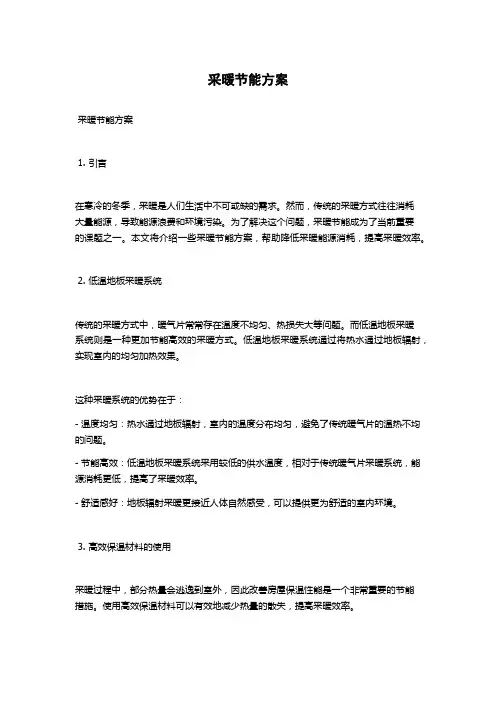
采暖节能方案采暖节能方案1. 引言在寒冷的冬季,采暖是人们生活中不可或缺的需求。
然而,传统的采暖方式往往消耗大量能源,导致能源浪费和环境污染。
为了解决这个问题,采暖节能成为了当前重要的课题之一。
本文将介绍一些采暖节能方案,帮助降低采暖能源消耗,提高采暖效率。
2. 低温地板采暖系统传统的采暖方式中,暖气片常常存在温度不均匀、热损失大等问题。
而低温地板采暖系统则是一种更加节能高效的采暖方式。
低温地板采暖系统通过将热水通过地板辐射,实现室内的均匀加热效果。
这种采暖系统的优势在于:- 温度均匀:热水通过地板辐射,室内的温度分布均匀,避免了传统暖气片的温热不均的问题。
- 节能高效:低温地板采暖系统采用较低的供水温度,相对于传统暖气片采暖系统,能源消耗更低,提高了采暖效率。
- 舒适感好:地板辐射采暖更接近人体自然感受,可以提供更为舒适的室内环境。
3. 高效保温材料的使用采暖过程中,部分热量会逃逸到室外,因此改善房屋保温性能是一个非常重要的节能措施。
使用高效保温材料可以有效地减少热量的散失,提高采暖效率。
常见的高效保温材料包括:- 聚苯乙烯泡沫板(EPS):具有良好的保温性能和隔热性能,适用于墙体、屋顶等部位。
- 玻璃棉:具有优良的保温、隔热、吸声性能,适用于屋顶、墙体、地板等部位。
- 聚氨酯泡沫板(PU):具有优异的保温性能和隔热性能,适用于墙体、屋顶等部位。
使用这些高效保温材料,可以减少能源消耗,提高采暖效果,实现可持续的采暖。
4. 智能温控系统的应用智能温控系统是一种采暖节能的创新技术。
通过智能温控系统,可以根据室内温度情况实现自动控制供暖设备的工作,避免能源的浪费。
智能温控系统的特点包括:- 温度控制精准:根据室内温度情况,进行智能调节,保持恒定的舒适温度。
- 时间控制灵活:根据居住习惯和需求,可以灵活设定供暖时间,避免空置时的能源消耗。
- 远程控制便捷:通过手机等设备,可以随时随地远程控制供暖设备的工作,实现更加便捷的操作。
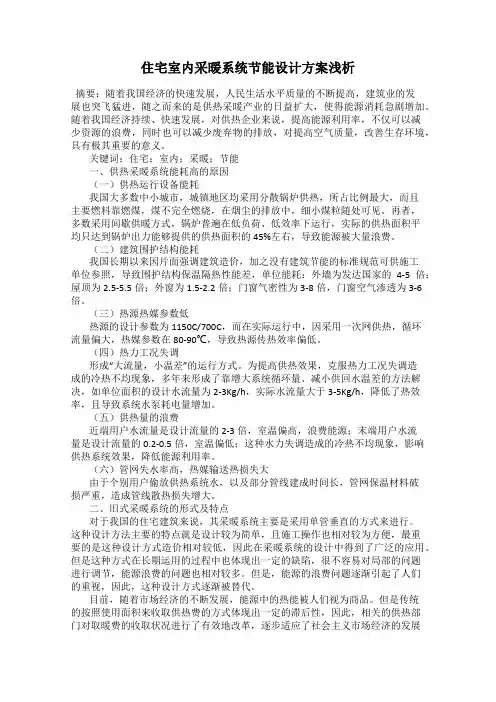
住宅室内采暖系统节能设计方案浅析摘要:随着我国经济的快速发展,人民生活水平质量的不断提高,建筑业的发展也突飞猛进,随之而来的是供热采暖产业的日益扩大,使得能源消耗急剧增加。
随着我国经济持续、快速发展,对供热企业来说,提高能源利用率,不仅可以减少资源的浪费,同时也可以减少废弃物的排放,对提高空气质量,改善生存环境,具有极其重要的意义。
关键词:住宅;室内;采暖;节能一、供热采暖系统能耗高的原因(一)供热运行设备能耗我国大多数中小城市,城镇地区均采用分散锅炉供热,所占比例最大,而且主要燃料靠燃煤,煤不完全燃烧,在烟尘的排放中,细小煤粒随处可见。
再者,多数采用间歇供暖方式,锅炉普遍在低负荷、低效率下运行,实际的供热面积平均只达到锅炉出力能够提供的供热面积的45%左右,导致能源被大量浪费。
(二)建筑围护结构能耗我国长期以来因片面强调建筑造价,加之没有建筑节能的标准规范可供施工单位参照,导致围护结构保温隔热性能差,单位能耗:外墙为发达国家的4-5倍;屋顶为2.5-5.5倍;外窗为1.5-2.2倍;门窗气密性为3-8倍,门窗空气渗透为3-6倍。
(三)热源热媒参数低热源的设计参数为1150C/700C,而在实际运行中,因采用一次网供热,循环流量偏大,热媒参数在80-90℃,导致热源传热效率偏低。
(四)热力工况失调形成“大流量,小温差”的运行方式。
为提高供热效果,克服热力工况失调造成的冷热不均现象,多年来形成了靠增大系统循环量、减小供回水温差的方法解决,如单位面积的设计水流量为2-3Kg/h,实际水流量大于3-5Kg/h,降低了热效率,且导致系统水泵耗电量增加。
(五)供热量的浪费近端用户水流量是设计流量的2-3倍,室温偏高,浪费能源;末端用户水流量是设计流量的0.2-0.5倍,室温偏低;这种水力失调造成的冷热不均现象,影响供热系统效果,降低能源利用率。
(六)管网失水率高,热媒输送热损失大由于个别用户偷放供热系统水,以及部分管线建成时间长,管网保温材料破损严重,造成管线散热损失增大。
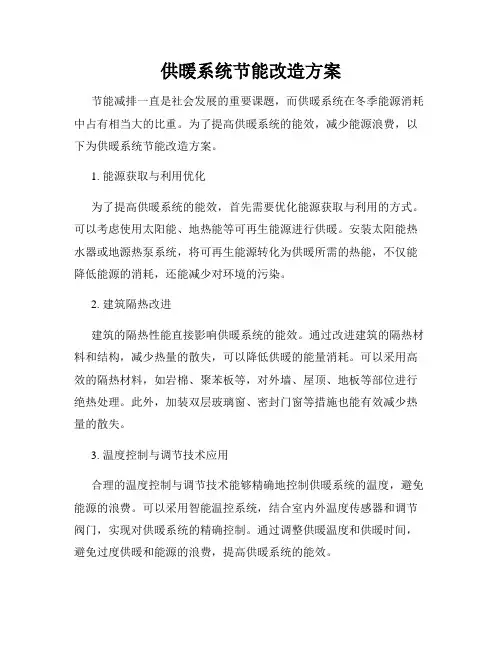
供暖系统节能改造方案节能减排一直是社会发展的重要课题,而供暖系统在冬季能源消耗中占有相当大的比重。
为了提高供暖系统的能效,减少能源浪费,以下为供暖系统节能改造方案。
1. 能源获取与利用优化为了提高供暖系统的能效,首先需要优化能源获取与利用的方式。
可以考虑使用太阳能、地热能等可再生能源进行供暖。
安装太阳能热水器或地源热泵系统,将可再生能源转化为供暖所需的热能,不仅能降低能源的消耗,还能减少对环境的污染。
2. 建筑隔热改进建筑的隔热性能直接影响供暖系统的能效。
通过改进建筑的隔热材料和结构,减少热量的散失,可以降低供暖的能量消耗。
可以采用高效的隔热材料,如岩棉、聚苯板等,对外墙、屋顶、地板等部位进行绝热处理。
此外,加装双层玻璃窗、密封门窗等措施也能有效减少热量的散失。
3. 温度控制与调节技术应用合理的温度控制与调节技术能够精确地控制供暖系统的温度,避免能源的浪费。
可以采用智能温控系统,结合室内外温度传感器和调节阀门,实现对供暖系统的精确控制。
通过调整供暖温度和供暖时间,避免过度供暖和能源的浪费,提高供暖系统的能效。
4. 水循环系统优化供暖系统中的水循环系统也是影响能效的重要因素。
可以采用高效的水泵和阀门,减少水泵的功耗,提高水循环的效率。
合理设置供水温度,以适应不同季节和室内温度的需求,避免过热导致能源浪费。
此外,可以考虑使用集中供热系统,减少供暖管道的损耗,提高供暖系统的能效。
5. 定期维护及系统监测供暖系统的定期维护和系统监测对于保持系统的良好运行状态和能效至关重要。
定期清洗供热管道和散热器,确保热量传递效果良好;检查水泵、阀门和温控设备等的工作状态,修复或更换损坏及老化部件;进行系统的漏水检测和能源消耗监测,及时发现问题并进行处理,以保证供暖系统的高效运行。
综上所述,供暖系统的节能改造方案包括优化能源获取与利用方式、改进建筑隔热性能、应用温度控制与调节技术、优化水循环系统以及定期维护和系统监测等方面。
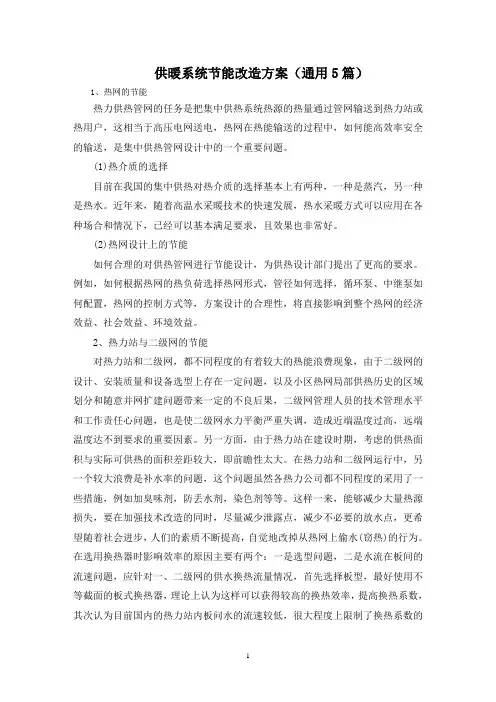
供暖系统节能改造方案(通用5篇)1、热网的节能热力供热管网的任务是把集中供热系统热源的热量通过管网输送到热力站或热用户,这相当于高压电网送电,热网在热能输送的过程中,如何能高效率安全的输送,是集中供热管网设计中的一个重要问题。
(1)热介质的选择目前在我国的集中供热对热介质的选择基本上有两种,一种是蒸汽,另一种是热水。
近年来,随着高温水采暖技术的快速发展,热水采暖方式可以应用在各种场合和情况下,已经可以基本满足要求,且效果也非常好。
(2)热网设计上的节能如何合理的对供热管网进行节能设计,为供热设计部门提出了更高的要求。
例如,如何根据热网的热负荷选择热网形式,管径如何选择,循环泵、中继泵如何配置,热网的控制方式等,方案设计的合理性,将直接影响到整个热网的经济效益、社会效益、环境效益。
2、热力站与二级网的节能对热力站和二级网,都不同程度的有着较大的热能浪费现象,由于二级网的设计、安装质量和设备选型上存在一定问题,以及小区热网局部供热历史的区域划分和随意并网扩建问题带来一定的不良后果,二级网管理人员的技术管理水平和工作责任心问题,也是使二级网水力平衡严重失调,造成近端温度过高,远端温度达不到要求的重要因素。
另一方面,由于热力站在建设时期,考虑的供热面积与实际可供热的面积差距较大,即前瞻性太大。
在热力站和二级网运行中,另一个较大浪费是补水率的问题,这个问题虽然各热力公司都不同程度的采用了一些措施,例如加臭味剂,防丢水剂,染色剂等等。
这样一来,能够减少大量热源损失,要在加强技术改造的同时,尽量减少泄露点,减少不必要的放水点,更希望随着社会进步,人们的素质不断提高,自觉地改掉从热网上偷水(窃热)的行为。
在选用换热器时影响效率的原因主要有两个:一是选型问题,二是水流在板间的流速问题,应针对一、二级网的供水换热流量情况,首先选择板型,最好使用不等截面的板式换热器,理论上认为这样可以获得较高的换热效率,提高换热系数,其次认为目前国内的热力站内板问水的流速较低,很大程度上限制了换热系数的提高,要改变那种板片换热面积越大越好的倾向,控制好板问流速是提高效率的有效手段。
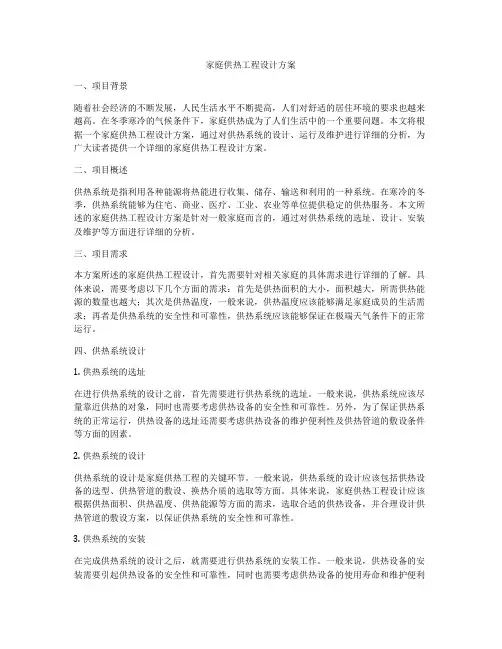
家庭供热工程设计方案一、项目背景随着社会经济的不断发展,人民生活水平不断提高,人们对舒适的居住环境的要求也越来越高。
在冬季寒冷的气候条件下,家庭供热成为了人们生活中的一个重要问题。
本文将根据一个家庭供热工程设计方案,通过对供热系统的设计、运行及维护进行详细的分析,为广大读者提供一个详细的家庭供热工程设计方案。
二、项目概述供热系统是指利用各种能源将热能进行收集、储存、输送和利用的一种系统。
在寒冷的冬季,供热系统能够为住宅、商业、医疗、工业、农业等单位提供稳定的供热服务。
本文所述的家庭供热工程设计方案是针对一般家庭而言的,通过对供热系统的选址、设计、安装及维护等方面进行详细的分析。
三、项目需求本方案所述的家庭供热工程设计,首先需要针对相关家庭的具体需求进行详细的了解。
具体来说,需要考虑以下几个方面的需求:首先是供热面积的大小,面积越大,所需供热能源的数量也越大;其次是供热温度,一般来说,供热温度应该能够满足家庭成员的生活需求;再者是供热系统的安全性和可靠性,供热系统应该能够保证在极端天气条件下的正常运行。
四、供热系统设计1. 供热系统的选址在进行供热系统的设计之前,首先需要进行供热系统的选址。
一般来说,供热系统应该尽量靠近供热的对象,同时也需要考虑供热设备的安全性和可靠性。
另外,为了保证供热系统的正常运行,供热设备的选址还需要考虑供热设备的维护便利性及供热管道的敷设条件等方面的因素。
2. 供热系统的设计供热系统的设计是家庭供热工程的关键环节。
一般来说,供热系统的设计应该包括供热设备的选型、供热管道的敷设、换热介质的选取等方面。
具体来说,家庭供热工程设计应该根据供热面积、供热温度、供热能源等方面的需求,选取合适的供热设备,并合理设计供热管道的敷设方案,以保证供热系统的安全性和可靠性。
3. 供热系统的安装在完成供热系统的设计之后,就需要进行供热系统的安装工作。
一般来说,供热设备的安装需要引起供热设备的安全性和可靠性,同时也需要考虑供热设备的使用寿命和维护便利性等方面的因素。

建筑节能太阳能采暖系统设计方案随着资源的日益枯竭和环境污染的日益加剧,建筑行业对于节能环保的需求也越来越迫切。
在现代建筑设计中,太阳能采暖系统成为了一种非常受欢迎和有效的节能方案。
本文将为您介绍一种建筑节能太阳能采暖系统设计方案。
一、系统概述该建筑节能太阳能采暖系统将太阳能作为能源,通过多种设备和技术达到供热的目的。
系统由太阳能集热器、储热装置、热水循环泵、辅助热源等多个组件组成,通过精确的控制和管理,实现整体供暖和热水的功能。
二、太阳能集热器太阳能集热器是整个系统的核心组件,其主要功能是将太阳辐射能转化为热能。
我们采用的是平板式太阳能集热器,其具有良好的热吸收性能和光透过率。
通过将集热器安装在建筑的南向墙面或屋顶,能够最大程度地吸收太阳能,实现高效的集热。
三、储热装置为了解决夜间或阴天等无法进行集热的情况,系统配备了储热装置。
我们采用的是水箱式储热装置,其通过储存大量的热水,能够使系统在无太阳能供热时依然能够正常运行。
另外,水箱式储热装置还可以通过与其它热源的耦合,从而实现能源的多元化利用。
四、热水循环泵热水循环泵是系统的关键设备之一,其通过循环泵和管道系统将热水从太阳能集热器传输到热源端或供暖端。
我们选用了高效、低噪音的循环泵,以减少能源的浪费和噪音对居住环境的影响。
五、辅助热源在天气条件不佳或夜间供暖时,太阳能集热器的供热能力通常无法满足需求。
因此,系统还配备了辅助热源,以保证供暖系统的正常运行。
我们可以选择使用燃气锅炉、电锅炉等作为辅助热源,根据实际需求进行选择。
六、控制管理系统为了实现对整个系统的智能控制和管理,我们将运用先进的自动化控制系统。
该控制系统能够根据室内外温度、太阳能辐射强度等参数进行智能调节,实现最佳供暖效果和能源利用效率。
同时,该系统还具备监测和报警功能,方便用户进行实时的状态监控和故障排查。
七、系统优势该建筑节能太阳能采暖系统设计方案具有以下优势:1. 节能环保:利用太阳能作为能源,无需使用传统能源,减少能源消耗和排放;2. 经济效益:太阳能是免费的能源,使用太阳能采暖系统可大幅减少供热成本;3. 智能调节:通过控制管理系统进行智能调节,提高供暖效果和能源利用率;4. 多元化利用:太阳能和辅助热源的耦合使用,实现能源的多元化利用;5. 可持续发展:太阳能是可再生能源,采用该系统有利于可持续发展。
目录摘要............................................................. (Ⅰ)Abstract (Ⅱ)1 绪论 (2)1.1选题的依据 (1)1.2集中供热系统的研究现状 (3)1.2.1国外研究现状 (3)1.2.2国内研究现状 (6)1.3本课题的研究内容、目的及意义 (8)1.3.1研究内容 (8)1.3.2课题目的及意义 (8)2 可编程序控制器简介与通用变频器概述 (10)2.1可编程序控制器简介 (10)2.1.1可编程序控制器的国内外状况 (10)2.1.2可编程序控制器的组成和原理 (12)2.1.3可编程控制器的发展趋势 (13)2.2通用变频器概述 (16)2.2.1通用变频器的发展过程 (16)2.2.2通用变频器的发展方向 (17)3某居民小区锅炉电气方案设计 (19)3.1问题的提出 (19)3.2锅炉自动控制系统的构成 (21)3.3锅炉设备变频器控制的设计 (22)3.4锅炉自动控制系统的设计 (23)3.4.1锅炉自动控制系统控制方式 (23)3.4.2锅炉自动控制系统设计要点 (24)3.4.3系统的硬件结构 (24)3.5传感器选型及信号输出 (29)3.6系统控制设计 (30)3.6.1 PLC控制 (30)3.6.2可编程终端监控 (31)3.6.3各机构PID控制说明 (31)3.6.4 PLC系统选型 (32)4系统安装、调试 (33)4.1点火前的检查 (33)4.2锅炉的上水与定压 (33)4.3现场调试步骤 (34)4.4手动控制顺序 (35)5 总结 (36)5.1节能分析 (36)5.2小区锅炉控制方式的优点 (37)参考文献 (38)致谢 (39)附图1 电气连接图 (40)附图2 梯形图 (44)附图3程序清单 (47)附图4设计总图 . . . . . . . . . . . . . . . . . . . . . . . . . . . 501 绪论我国供暖规模大,发展快,集中供热已成为我国北方冬季供热的一种主要形式,并得到了越来越广泛的推广和应用。
节能施工方案降低住宅楼采暖能耗在当今社会,节能减排成为了一项重要的任务。
随着全球能源消耗的不断增加,减少能源浪费,提高能源利用效率变得尤为迫切。
其中,住宅楼的采暖能耗占比较大,因此采取节能施工方案来降低住宅楼采暖能耗成为了一个重要的课题。
一、外墙保温在住宅楼施工时,采用外墙保温是一个有效的节能措施。
通过在住宅楼外墙加保温层,可以有效降低能源的消耗。
常见的外墙保温材料有EPS板、岩棉板、聚氨酯板等。
这些材料具有良好的保温性能,可以减少外墙与室内的热传导,达到节能效果。
二、优化建筑结构在住宅楼的设计和施工过程中,可以进行结构优化,减少能源的浪费。
例如,合理设计建筑的朝向和窗户的位置,以最大程度地利用自然光和自然通风,减少人工照明和空调的使用。
此外,采用节能型玻璃和隔热材料等也是降低能耗的有效方法。
三、采用高效暖气设备在住宅楼的采暖系统中,选择高效暖气设备是非常重要的。
传统的采暖方式如锅炉采暖存在能源浪费的问题,而采用地源热泵、太阳能热水器等绿色能源设备可以大大减少能源消耗。
此外,智能温控系统的使用也可以实现精确调节室内温度,进一步降低能耗。
四、加强能源管理和监测为了降低住宅楼采暖能耗,加强能源管理和监测是必不可少的。
通过对能源的监测和分析,可以发现能源的浪费情况,并及时采取措施进行优化。
同时,建立定期能源管理评估制度,监督施工方案的落实情况,确保节能效果的持续改善。
综上所述,通过采取节能施工方案,可以有效降低住宅楼的采暖能耗。
当然,在施工过程中还需要注意合理使用材料和技术,提高施工质量,减少能源的浪费。
只有持续关注节能减排问题,不断探索创新,才能为人们提供更舒适、更环保的居住环境。
《民用建筑节能设计标准(采暖居住建筑部分)》一、引言本标准旨在规范民用建筑采暖居住部分的节能设计,提高建筑能源利用效率,减少能源消耗,保护环境,促进可持续发展。
二、适用范围本标准适用于民用建筑采暖居住部分的节能设计,包括住宅、宾馆、酒店、公寓等各类居住建筑。
三、术语和定义3.1节能设计:指在满足建筑采暖居住需求的前提下,通过合理的设计措施减少能源消耗,提高能源利用效率。
3.2采暖居住建筑:指以提供温暖舒适的居住环境为主要功能的建筑。
3.3能源利用效率:指建筑中采暖系统提供的热量与消耗的能源之间的比值。
3.4环境保护:指通过减少能源消耗、减少二氧化碳排放等措施,保护自然环境,减少对环境的负面影响。
3.5可持续发展:指在满足现代社会需求的同时,不损害未来世代满足其需求的能力。
四、节能设计要求4.1建筑外墙保温4.1.1采用合适的保温材料对建筑外墙进行保温,提高建筑的保温性能。
4.1.2外墙保温层的厚度应符合国家相关标准的要求,确保保温效果达到预期。
4.2采暖系统设计4.2.1选用高效的采暖设备,如燃气锅炉、地源热泵等,提高能源利用效率。
4.2.2设计合理的供暖面积和布局,使得采暖系统工作更加稳定、高效。
4.2.3采用智能控制系统,根据室内温度、室外温度等参数进行自动调节,提高采暖系统的控制精度。
4.3内部热量利用4.3.1优化建筑内部热源的布局,使得热量能够充分利用。
4.3.2采用适当的通风设计,利用热量对流,提高能源利用效率。
五、检测与验收5.1完成建筑节能设计后,应进行相应的检测和验收,确保设计方案符合本标准要求。
5.2检测和验收应由专业机构或相关行业组织进行,确保检测结果的客观性和可靠性。
六、总则6.1本标准的编制遵循科学性、技术性、规范性的原则。
6.2本标准的修订和解释权归相关部门所有。
6.3本标准自发布之日起实施。
七、附则7.1本标准未涉及的内容,可参考相关国家标准和行业规范。
7.2对于已存在的建筑,如需进行节能改造,可参考本标准进行设计和施工。
高层住宅供暖节能施工设计方案随着城市化的进展,高层住宅作为城市居住的主要形式之一,对于供暖系统的节能需求也日益增加。
为了提供高效可靠的供暖服务,同时满足节能要求,本文将介绍一种适用于高层住宅的节能供暖施工设计方案。
1. 系统选型:为了实现供暖系统的节能效果,我们选择采用高效的地源热泵系统。
地源热泵系统利用地下深层的恒温热源,通过热泵技术将地热能转化为供暖和热水供应。
这一系统具有供暖效果好、能源利用率高、环境友好等特点,非常适合高层住宅的供暖需求。
2. 热源井设计:为了实现地源热泵系统的供热效果,我们需要设计合理的热源井。
首先,根据项目需求和地质条件,选择合适的井深和井径。
然后,根据实际情况选用适当的导热管材料,确保热能的传导效果。
同时,需要进行合理的井间距和井排布设计,以充分利用地热资源,并减少热能的损失。
3. 热泵系统设计:为了提高地源热泵供暖系统的效率,我们需要进行系统的合理设计。
首先,选用高效的热泵设备,比如采用变频调节技术的热泵,能够根据实际供暖需求灵活调整运行状态,提高节能效果。
其次,需要进行合理的配管设计,确保热能的传输损失最小化。
此外,还需要进行系统的定时控制和温度调节,以满足不同户型和居民的舒适需求。
4. 室内供暖设计:针对高层住宅室内供暖设计,我们应采取合理的布局和节能措施。
首先,选择合适的供暖器具,如具有自动控制和温度调节功能的暖气片等,可以根据室内温度和季节需求进行自动调节,减少能源浪费。
其次,进行良好的隔热设计,包括墙体、窗户、屋顶等部位的绝热材料选择和施工,减少室内外热量交换。
此外,还可以采用低温地板供暖等新技术,提高供暖效果,减少能耗。
5. 节能监测与调整:为了确保供暖系统的节能效果持续有效,我们需要进行监测与调整。
可以安装能源监测系统,实时监测供暖系统的运行状态和能耗情况,及时发现问题并进行调整。
此外,还可以定期进行能源消耗的分析和评估,找出节能潜力,进一步改进系统设计和运行方式。
住宅室内采暖系统节能设计方案(Energy saving design scheme of residential indoor heating system)The energy-saving design of residential indoor heating systemEnergy conservation is a long-term strategic policy of china. The Chinese government attaches great importance to energy saving work, especially after the reform and opening up energy-saving work appeared thriving situation. Energy saving for the heating industry potential is quite large. The heating industry is large energy consumption, energy consumption expenditure occupy most of its cost. Because the previous residential heating heat fee according to the area, there is much irrationality, and is not convenient for the users of local regulation, causing great waste heat heating. With the continuous development of the improvement of people's living and heating business, to achieve the heating system with heat metering and independent control is more and more high.In recent years, such problems in heating system design has been paid more and more attention. So it is necessary to meet the need of heat metering charges by using more suitable forms ofheating system in new residential. In such problems, especially should pay special attention to the energy utilization process before, namely the design of the heating system in the planning, should consider the prospects of energy saving and economic benefit of the system. The Ministry of construction construction 95 plan and the 2010 plan clearly pointed out that he civil construction and installation of central heating heat meter and related regulating equipment andthepromote to began success, pilot through 1998 work, metering implementation of small area in 2000 2010 in the new key city, comprehensive promotion. Therefore, in the design of indoor heating system, the designer should consider the needs of users of household heat and room temperature control. According to preliminary estimates, take household metering heating, heating and energy saving can be achieved more than 20%. In this paper, several kinds of household metering heating system for an analysis.2, the basic form of the old heating system and its advantages and disadvantagesFor a long time, basically adopts the single vertical system design design of city residential indoor heating system in china. (Figure 1) this design has many advantages: 1 simple and convenient construction system; 2; 3 low cost, but also has some defects, is not convenient for the users of local regulation, thus causing a waste of energy. With the change of energy structure and energy saving and property management requirements, this problem is more and more obvious, the heating system had to be replaced.With the development of our socialist market economy, hot is the view of commodities has gradually been recognized and accepted by people. The traditional method of backward construction area by clearing fees, is neither scientific nor reasonable. Has been unable to meet the requirements of socialist market economic system must be reformed, metering and charging. Heating charges by the planned economy period of the welfare system to socialist market economic system, namely the userThe fee. heating pay enterprises heating the heat to userof energy-saving heating system more and more attention. Single pipe vertical heating system defects more and more obvious, thedisadvantages in the following aspects:2.1 system does not have the ability of individual adjustmentThe main disadvantage of single pipe vertical heating system is not conducive to local regulation, to improve and meet the thermal comfort requirements of heat users. And because the system is the first hot water for residential buildings to the top, then turn down to the user, which in theory caused by the heat transfer coefficient of K radiator heat users on different floors of the values are not equal. The resulting top bottom overheating too cold, uneven phenomenon. The top user overheating only through the open doors and windows way to let the heat to reduce the indoor temperature, which resulted in a waste of energy. If by adjusting the hot water flow to reduce the room temperature, it will cause the following layers of supercooling phenomenon. Secondly, the system is unable to each room separately adjusted, resulting in a waste of energy.A waste of energy 2.2 system maintenanceThe single pipe vertical heating system is an integral part ofthe hot water circulation system. If the system has a facility Water Leakage or blocked, the whole system will be affected. May cause the whole building stop for serious; and will cause a lot of hot water in the maintenance of the waste,In the cold areas may appear serious problems such as water supply pipe burst, causing unnecessary accidents, affecting the normal life of the residents.2.3 is not conducive to the management of heating DepartmentFor users with difficult heating fee arrears, if you want to stop individual user heating, may affect the entire residential building for stop. Often this down, heating enterprises to make ends meet, years of losses.2.4 idle residential energy wasteAs the indoor heating system is a tube series, so each layer, each house must use heat, otherwise the system will not work correctly. If some users do not want to use heat or some residential long idle, this will inevitably lead to a waste ofenergy. At present in some non heating and heating in residential development areas, this phenomenon is very prominent.The development prospect and control principle, 3 household meteringAt present, in our country, the study of household metering system has just started, most of them in the trial stage. The indoor heating system for the original single and vertical system, lack of independent adjustment ability, heat users is commodity without a deep understanding of heat, lack of awareness of energy saving, only the energy consumption of residential heating units in China area is about 2 times higher in advanced countries, and does not facilitate the heating heatingmetering household the to According management. sector system heating is the direction of development, is the only way to solve difficult charge and saveenergy. With the improvement of living standards people are no longer satisfied with the full and warm, but the constant pursuit of high quality, high quality of life. In Jiangsu Huaian City, new housing each year nearlyone million square meters, the new residential mostly in the application of indoor heating, and the Huaian municipal government is currently only West courtyard heating system. Because the city residential indoor heating has just started, so it should be at the forefront of heating in the form of promotion, promotion prospects the implementation of single household heating in the form of control is very considerable.The characteristics of household metering heating system is controlled individually for each user that is independent of each household heating, using a water supply and return system, a table system, the user can separate regulation, shutdown, metering, does not affect other users. To achieve the fundamental method of household metering purpose is to control the user independent system, the specific approach is to set the table and the heat radiator installed on the valve in the household water supply at the entrance. By adjusting the radiator heating room temperature to satisfy the human thermal comfort requirements. Implementation method of radiator adjustment, mainly by controlling the heat dissipation, to meet the temperature requirements. The current regulation is achieved mainly depends on individual radiator radiator hotwater flow into the flow change, but must not affect the whole supply regulation method in radiator regulation, is mainly controlled by the heat dissipation, to meet the temperature requirements. The current regulation is achieved mainly depends on the individual radiator method changes into the flow radiator water flow, but must not affect the hydraulic stability of heating system in the radiator heating system regulation, so to improve the regulation and control measures and a high level of operation and management. Otherwise, it is difficult to achieve the true sense of the household metering.4, suitable for household metering heating system4.1 single control heating system4.1.1 horizontal one pipe systemHorizontal one pipe system is a relatively common heating system. It is a total of supply and return water system is provided in each apartment (called system), each user is a small independent system. The total supply and return water riser pipe in the kitchen by the stairs, each layer of supply andreturn water in contact with the large system (each layer only households), and adjust the valve is shut off and heat metering system in the small entrance pipeline, so that the household heat metering and charging. The advantages of this system are: vertical riser wear floor, does not affect the wall decoration; the shortcoming is: can not control room temperature; each radiator shall air valve; pipeline, the balcony must pass.4.1.2 (single level crossing systemFigure 3 the system principle diagram, with the same type of horizontal series one pipe system, using a large system, the system of supply and return water pipe arranged in the pipeline well.This design scheme should be added and the radiator group number corresponding to the number three valve, control the maximum flow into the radiator for circulating flow 30%. The advantages of this method are: to achieve room temperature control; vertical riser, does not affect the wall decoration; the shortcoming is: ancillary equipment in the pipeline (three valve); pipeline door, balcony should handle each radiator cold air valve shall be provided.4.2 pipe heating system4.2.1 double riser parallel systemFor the double riser parallel system, any layer as long as the user in the radiator pipe and valve can achieve regulating media flow, so as to satisfy the requirements of thermal comfort and energy saving. But this adjustment is in use, should consider the following questions: (a) in the number of floors too prone to the phenomenon of serious vertical imbalance, the vertical height of not more than three layers is appropriate, practical restrictions. (b) across the floor of the riser number. (c) only method suitable for installation of the system heat distribution table adjustment, mainly by controlling the heat dissipation, to meet the temperature requirements. The current regulation is achieved mainly depends on the individual radiator method changes into the flow radiator water flow, but must not affect the hydraulic stability of heating system in the radiator heating system regulation, so to improve the regulation and control measures and a high level of operation and management.4, suitable for household metering heating system4.1 single control heating system4.1.1 horizontal one pipe systemHorizontal one pipe system is a relatively common heating system. It is a total of supply and return water system is provided in each apartment (called system), each user is a small independent system. The total supply and return water riser pipe in the kitchen by the stairs, each layer of supply and return water in contact with the large system (each layer only households), and adjust the valve is shut off and heat metering system in the small entrance pipeline, so that the household heat metering and charging. The advantages of this system are: vertical riser wear floor, does not affect the wall decoration; the shortcoming is: can not control room temperature; each radiator shall air valve; pipeline, the balcony must pass.4.1.2 single level crossing systemWith the same type of horizontal series one pipe system, using a large system, the system of supply and return water pipe arranged in the pipeline well. This design scheme should be added and the radiator group number corresponding to the number three valve, control the maximum flow into the radiator for circulating flow 30%. The advantages of this method are: to achieve room temperature control; vertical riser, does not affect the wall decoration; the shortcoming is: ancillary balconydoor, pipeline valve); (three pipeline the in equipment should handle each radiator cold air valve shall be provided.4.2 pipe heating system4.2.1 double riser parallel systemFor the double riser parallel system, any layer as long as the user in the radiator pipe and valve can achieve regulating media flow, so as to satisfy the requirements of thermal comfort and energy saving. But this adjustment is in use, should consider the following questions: (a) in the number of floors too prone to the phenomenon of serious vertical imbalance, the verticalheight of not more than three layers is appropriate, practical restrictions. (b) across the floor of the riser number. (c) system is only applicable to the installation of heat distribution table.The level of 4.2.2 pipe systemThe design scheme of double level, can avoid the double riser parallel system of vertical imbalance, and the system can realize an independent system for household heat meter installation, can realize the regulation of individual radiator. Any layer users can conveniently adjust the medium flow through the indoor control valve, so as to achieve a comfortable room temperature, and to achieve the purpose of saving energy, and does not affect other users of heating, but the system should be added and the radiator group number corresponding to the number three valve. The advantages of the scheme that the problem of vertical imbalance of heating system temperatureroom improved; greatly be can solve to easy not iscontrol,The adjusting performance is better than single pipe system; wall vertical riser, does not affect the disadvantages are: indoor decoration; the lower part of the radiator for backwater pipeline, the balcony door hidden difficulties; bad treatment; cold air valve shall be installed on each radiator5, should pay attention to the problems in the design of heating systemAlthough the household metering has powerful promotion in the new residential area, but in the implementation process inevitably there are some problems in the design of heating system, building design, instrument selection, management etc..5.1 heating system heat load calculation and indoor radiatorHeat load calculation is the basis of heating system design, the design for fear of heating is not blindly increase the hot load value, so that the radiator installation area is too large, will not be conducive to the regulation of temperature control valve on the radiator pipe, the heat index should choose areasonable estimation method. The indoor radiator location to a reasonable layout, indoor level pipeline will increase, with the existing pipeline space, the influence of interior decoration, furniture layout and balcony doors, difficult to deal with such problems.The 5.2 building materials on the heat transfer performance requirementsThe new building materials can meet the requirements of modern energy-saving room, the heat transfer performance of building materials is ideal. Heating and heat loss of buildings is mainly constituted by the heat retaining structure, accounting for about 73%~77%, followed by the penetration of heat through the air gap of doors and windows, accounting for about 23%~27%, in the heat wall accounted for 23%~34%, thus improving the building insulation performance will reach a good energy saving effect. In addition, the calculation shows that for a non heating room from around the room to obtain the heat transfer can be maintained at 12~14 at room temperature, other users have nearly 1/4~1/5 of the heat to the room, other users will pay more for this part of the heat fee is not reasonable. Therefore,it is necessary to strengthen the house building structure 5.3 heat insulation performance parameters correction and meter checking problem because the envelope tenants are located, different, there must be differences in the same room temperature to keep the heat consumption, heat meter parameters should be chosen so reasonable. My unit meter at the same table, user verification, heat fee settlement occurred in the dispute. Moreover, the organization of specialized personnel should regularly check meter.5.4 flow heating systemSince the implementation of household metering system, the change of heat load will be very frequent, so the heating system should be able to automatically adjust the amount of heating, the heat load of the track changes required. Should be in the heat exchange station is provided with a device of differential pressure control.5.5 residential setting household metering device, to strengthen energy-saving publicity to raise awareness of energy conservation.Put forward higher requirements for the management of 5.6 heating enterprises.6, conclusionIn summary, for the design of heating system in residential district planning and design, if reasonable, can not only realize the system control and measurement function better, and can reduce energy waste, improve heating social benefits and considerable economic benefits.。